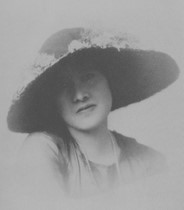Events 2008
February 7th, 2008
On the Trail of the Urban Nomad in the Tokyo of the 1980sJonathan Reynolds (Associate Professor, Barnard College)
403 Kent Hall, Columbia University (116th St. and Amsterdam Ave.)
6:00 – 7:30 PM
February 13th, 2008
Woman on the Other Shore: An Evening with Mitsuyo KakutaMitsuyo Kakuta, Writer
301 Philosophy Hall, Columbia University (116th St. and Amsterdam Ave.)
6:00 – 7:30 PM
 |
| Copyright Osamu Koizumi |
Mistuyo Kakuta was born in Yokohama in 1967. She began her writing career while still a student at Waseda University. She is the author of over a dozen books and the recipient of several literary awards, including Japan's most prestigious for popular fiction, the Naoki Prize, which she won for Woman on the Other Shore.
This event is co-sponsored by the Japan Foundation and the Weatherhead East Asian Institute.
February 22nd, 2008
Edward Seidensticker (1921-2007):A Celebration of Lifetime Achievement in Japanese Literary Studies
C. V. Starr East Asian Library, 300 Kent Hall, Columbia University
5:30 – 7:30 PM
RSVP to Tamara Kachanov, Departmental Administrator, Department of East Asian Languages and Cultures, tk7@columbia.edu
March 27th, 2008
Householders: The Reizei Family in Japanese HistorySteven Carter (Professor, Stanford University)
403 Kent Hall, Columbia University (116th St. and Amsterdam Ave.)
6:00 – 7:30 PM
 Housholders presents the history of the Reizei House—a noble lineage descended from Fujiwara no Teika—as a house, rather than as a genealogy of individual poets. This study goes against the grain of much traditional scholarship in that it places emphasis less on individuals than on the various roles of those individuals in a larger collective effort. In Householders, Prof. Steven Carter contends that a close reading of the various texts and artifacts of the Reizei, which we are fortunate to have in abundance, reveals that by their nature those materials virtually demand such an approach. In that sense, the approach of traditional scholarship on Japanese court poetry of the late medieval and early modern eras is in need of re-examination.
Housholders presents the history of the Reizei House—a noble lineage descended from Fujiwara no Teika—as a house, rather than as a genealogy of individual poets. This study goes against the grain of much traditional scholarship in that it places emphasis less on individuals than on the various roles of those individuals in a larger collective effort. In Householders, Prof. Steven Carter contends that a close reading of the various texts and artifacts of the Reizei, which we are fortunate to have in abundance, reveals that by their nature those materials virtually demand such an approach. In that sense, the approach of traditional scholarship on Japanese court poetry of the late medieval and early modern eras is in need of re-examination.
This talk will begin with a brief statement by Prof. Carter about how he became interested in the Reizei House, and then will focus on passages from the book that deal with the house as an enterprise dedicated to a particular kind of professional practice that involved not just composing poems but also politics, teaching, critique, textual services, and ritual activities.
April 7th, 2008
Japanese Style Shifts and Social Identities: The Case of JFL Learners and their Host FamiliesHaruko Cook (Professor, University of Hawai'i at Manoa)
403 Kent Hall, Columbia University (116th St. and Amsterdam Ave.)
6:00 – 7:30 PM
 For many American college students who study in Japan, living with a Japanese host family is a highlight of their study abroad experience. Many of them report that they learned Japanese most from talking with their host family members. How do learners of Japanese as a foreign language (JFL learners) learn Japanese and acquire new social identities in interaction with their host families? One of the ways in which speakers display their social identities in Japanese is through style shifts between the addressee honorific masu and non-honorific plain forms. In the homestay context, in which style do the participants interact with each other? What social identities are indexed by the use of the masu or plain form in dinnertime talk between the learner and host family? Based on dinnertime conversation data from nine JFL learners and their Japanese host families, this talk attempts to answer questions concerning co-construction of social identities through style shift in the homestay context.
For many American college students who study in Japan, living with a Japanese host family is a highlight of their study abroad experience. Many of them report that they learned Japanese most from talking with their host family members. How do learners of Japanese as a foreign language (JFL learners) learn Japanese and acquire new social identities in interaction with their host families? One of the ways in which speakers display their social identities in Japanese is through style shifts between the addressee honorific masu and non-honorific plain forms. In the homestay context, in which style do the participants interact with each other? What social identities are indexed by the use of the masu or plain form in dinnertime talk between the learner and host family? Based on dinnertime conversation data from nine JFL learners and their Japanese host families, this talk attempts to answer questions concerning co-construction of social identities through style shift in the homestay context. April 10th, 2008
Beyond Jakuchu's Surfaces: Painting Techniques and Conservation of an 18th-century MasterworkKent Hall Lounge, 4th Floor, Kent Hall, Columbia University
5:30 – 7:30 PM
"New Discoveries in Japanese Painting through Conservation Treatments"
Jennifer Perry, Associate Conservator for Asian Paintings, The Cleveland Museum of Art
"Jakuchu Inside Out: Verso Painting and Other Technical Aspects of the Colorful Realm of Living Beings"
April 16th, 2008
The Days After the SurrenderDonald Keene (Professor Emeritus, Columbia University)
301 Philosophy Hall, Columbia University (116th St. and Amsterdam Ave.)
6:00 – 7:30 PM
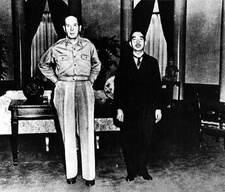 During the hectic days immediately following the Emperor's broadcast announcing the Japanese surrender in August 1945, several writers recorded their reactions in diaries. These diaries, more trustworthy and moving than later recollections or newspaper accounts, give a vivid picture of what it meant to be a writer at a time when all values were suddenly turned topsy-turvy.
During the hectic days immediately following the Emperor's broadcast announcing the Japanese surrender in August 1945, several writers recorded their reactions in diaries. These diaries, more trustworthy and moving than later recollections or newspaper accounts, give a vivid picture of what it meant to be a writer at a time when all values were suddenly turned topsy-turvy.
A reception will follow the talk.
Book Culture will be selling copies of Prof. Keene's forthcoming autobiography, Chronicles of My Life: An American in the Heart of Japan, at the talk.
This event is open to the public free of charge. No RSVP is necessary.
April 18th, 2008
Award Ceremony for the Japan-U.S. Friendship Commission Prize for the Translation of Japanese LiteratureC.V. Starr East Asian Library, Kent Hall, Columbia University
6:00 – 8:00 PM
Anthony H. Chambers for his translation of Tales of Moonlight and Rain by Akinari Ueda
Kozue Uzawa and Amelia Fielden for their translation of Tanka poems in Ferris Wheel: 101 Modern and Contemporary Tanka
A reception will follow the ceremony.
This event is open to the public free of charge. Please RSVP by Friday, April 11, 2008 by email to donald-keene-center@columbia.edu or by fax to 212-854-4019.
May 1st, 2008
Gloss Writing in the 8th Century: Korean Kugyŏl and the Origins of Japanese KanbunJohn Whitman (Professor, Cornell University)
403 Kent Hall, Columbia University (116th St. and Amsterdam Ave.)
6:00 – 7:30 PM
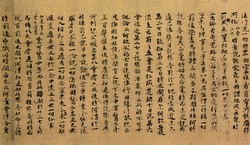 This talk concerns a manuscript that was destroyed in the B-29 raid on Tokyo on April 15, 1945. One side was an untitled, undated text known as the Tôdaiji fuju monkô (Draft of a Sermon for Tôdaiji Temple). On the reverse side was inscribed one of two extant copies of a sutra commentary, the Kegon mongi yôketsu (Key to the Text and Meaning of the Avatamsaka Sutra), approximately datable to the late eighth century. In the 1930s Yamada Yoshio and others noticed that the Tôdaiji fuju monkô was the earliest example of "mixed" kanji and katakana writing, with katakana written by the same hand, on the same line (as well as in the margin) as Chinese characters in the text. The Kegon mongi yôketsu similarly attracted attention among scholars, including Kobayashi Yoshinori, who showed that the system of glossing (kunten) it uses is nearly identical to those in stylus-pointed texts from the ancient Korean states of Late Shilla and Koryo. This discovery has led to a flurry of interest in the hypothesis that kunten glossing technology was brought from Shilla to Nara in the mid- to late eighth century, as part of the transmission of Huayan/Kegon doctrine and texts at that time. In his talk, Prof. Whitman will look at the two texts in brief detail. He will discuss what it means to gloss a text "to be read in a language" and will consider the relationship between glossing and construction of a written vernacular.
This talk concerns a manuscript that was destroyed in the B-29 raid on Tokyo on April 15, 1945. One side was an untitled, undated text known as the Tôdaiji fuju monkô (Draft of a Sermon for Tôdaiji Temple). On the reverse side was inscribed one of two extant copies of a sutra commentary, the Kegon mongi yôketsu (Key to the Text and Meaning of the Avatamsaka Sutra), approximately datable to the late eighth century. In the 1930s Yamada Yoshio and others noticed that the Tôdaiji fuju monkô was the earliest example of "mixed" kanji and katakana writing, with katakana written by the same hand, on the same line (as well as in the margin) as Chinese characters in the text. The Kegon mongi yôketsu similarly attracted attention among scholars, including Kobayashi Yoshinori, who showed that the system of glossing (kunten) it uses is nearly identical to those in stylus-pointed texts from the ancient Korean states of Late Shilla and Koryo. This discovery has led to a flurry of interest in the hypothesis that kunten glossing technology was brought from Shilla to Nara in the mid- to late eighth century, as part of the transmission of Huayan/Kegon doctrine and texts at that time. In his talk, Prof. Whitman will look at the two texts in brief detail. He will discuss what it means to gloss a text "to be read in a language" and will consider the relationship between glossing and construction of a written vernacular. October 2nd, 2008
6:00 - 7:30 PM"A Thousand Years of Genji: Envisioning the Tale of Genji, Canonization, Popularization, and Visual Culture"
Haruo Shirane, Professor of Japanese Literature, Columbia University
Location: 403 Kent Hall, Columbia University (116th St. and Amsterdam Ave.)
 To celebrate the one-thousandth anniversary of The Tale of Genji, one of the great classics of Japanese literature, the Keene Center presents a special lecture by Haruo Shirane, Shincho Professor of Japanese Literature at Columbia University. Prof. Shirane is an eminent Genji scholar and is editor of the recent publication Envisioning the Tale of Genji: Media, Gender, and Cultural Production (Columbia University Press, 2008). A reception follows the talk.
To celebrate the one-thousandth anniversary of The Tale of Genji, one of the great classics of Japanese literature, the Keene Center presents a special lecture by Haruo Shirane, Shincho Professor of Japanese Literature at Columbia University. Prof. Shirane is an eminent Genji scholar and is editor of the recent publication Envisioning the Tale of Genji: Media, Gender, and Cultural Production (Columbia University Press, 2008). A reception follows the talk.
This lecture is offered as part of a special Genji Millennium celebration.
October 16th, 2008
6:00 - 7:30 PM"The World in a Sign: Written Communication in Japan's Public Places"
Patricia J. Wetzel, Professor of Japanese, Portland State University
Location: 403 Kent Hall, Columbia University (116th St. and Amsterdam Ave.)
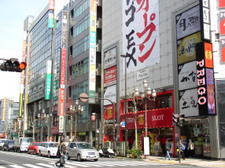 Across the urban landscape of Japan we see advertisements, directives, warnings, and maps that aim to establish a fictitious relationship between the “voice” of the sign and the reader. How are we to apprehend the characters in these narratives? Who are they to us? And who are we to them? Public texts tell us much about how language and place combine to reinforce, re-invent, play upon, and sometimes undermine longstanding cultural and linguistic practices.
Across the urban landscape of Japan we see advertisements, directives, warnings, and maps that aim to establish a fictitious relationship between the “voice” of the sign and the reader. How are we to apprehend the characters in these narratives? Who are they to us? And who are we to them? Public texts tell us much about how language and place combine to reinforce, re-invent, play upon, and sometimes undermine longstanding cultural and linguistic practices.
This lecture is offered as the Third Shirato Lecture on Japanese Language.
October 23rd, 2008
6:00 - 7:30 PM"Individuality in An Age of Reproduction: Utagawa Toyokuni and the Actor's Image in Nineteenth-Century Japan"
Jonathan Zwicker, Professor of Japanese Literature, University of Michigan
Location: 403 Kent Hall, Columbia University (116th St. and Amsterdam Ave.)
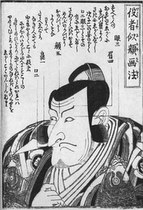 Using a variety of printed materials, this lecture examines the status of the individual visage in Japan during the first quarter of the nineteenth century. The opening decades of that century were a moment of emerging tension between an epistemology of reproducibility and assorted discourses of individuality. The present talk situates the mass reproduction of the actor's image in prints and novels within a framework bounded on one end by technologies of reproduction and on the other by an increasing anxiety over the status of the unique and the authentic.
Using a variety of printed materials, this lecture examines the status of the individual visage in Japan during the first quarter of the nineteenth century. The opening decades of that century were a moment of emerging tension between an epistemology of reproducibility and assorted discourses of individuality. The present talk situates the mass reproduction of the actor's image in prints and novels within a framework bounded on one end by technologies of reproduction and on the other by an increasing anxiety over the status of the unique and the authentic. October 30th, 2008
6:00 - 7:30 PM"The Four Great Temples"
Donald F. McCallum, Professor of Art History, UCLA
Location: 930 Schermerhorn, Columbia University (118th St. and Amsterdam Ave.)
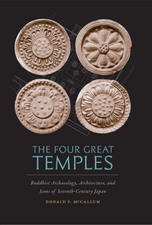 Historically, the most important temples at the initial stages of Buddhism in Japan were a group referred to in early historical documents as "The Four Great Temples." These temples--Asukadera, Kudara Odera, Kawaradera, and Yakushiji--occupied key roles during the Asuka and Hakuho periods, and continued to be important in the Nara period after their transfer to the new capital. The sites of Asukadera, Kawaradera, and Yakushiji have long been known. The first two were excavated in the 1950s, while Yakushiji has been excavated more recently. However, the location of Kudara Odera long remained a mystery. Only in 1997, when investigations of a site called Kibi Pond began, was the mystery solved. This lecture considers the textual, archaeological, and art historical evidence needed to reconstruct the actual situations of the central temples of early Japanese Buddhism.
Historically, the most important temples at the initial stages of Buddhism in Japan were a group referred to in early historical documents as "The Four Great Temples." These temples--Asukadera, Kudara Odera, Kawaradera, and Yakushiji--occupied key roles during the Asuka and Hakuho periods, and continued to be important in the Nara period after their transfer to the new capital. The sites of Asukadera, Kawaradera, and Yakushiji have long been known. The first two were excavated in the 1950s, while Yakushiji has been excavated more recently. However, the location of Kudara Odera long remained a mystery. Only in 1997, when investigations of a site called Kibi Pond began, was the mystery solved. This lecture considers the textual, archaeological, and art historical evidence needed to reconstruct the actual situations of the central temples of early Japanese Buddhism. November 20th, 2008
"Paris on My Mind: Yosano Akiko and Europe"Janine Beichman, Professor, Daito Bunka University and Visiting Scholar 2008-2009, Columbia University
Location: 403 Kent Hall, Columbia University (116th St. and Amsterdam Ave.)
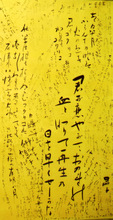 From may to October of 1912, Yosano Akiko, the most renowned woman poet of twentieth-century Japan, traveled to Europe for the first and last time in her life. The journey out was made overland by the newly constructed Trans-Siberian Railway, the journey back by boat from Marseilles. Short as Akiko's stay in Europe was, the experience changed her as a writer in important ways. It also became the seed for some of her most original and moving poems and essays. Like other works of her maturity, these writings were largely overlooked until recently, but they in fact are among the hidden treasures of world travel literature.
From may to October of 1912, Yosano Akiko, the most renowned woman poet of twentieth-century Japan, traveled to Europe for the first and last time in her life. The journey out was made overland by the newly constructed Trans-Siberian Railway, the journey back by boat from Marseilles. Short as Akiko's stay in Europe was, the experience changed her as a writer in important ways. It also became the seed for some of her most original and moving poems and essays. Like other works of her maturity, these writings were largely overlooked until recently, but they in fact are among the hidden treasures of world travel literature.